Donor Government Assistance for Family Planning in 2014
Executive Summary
Executive Summary
For the second consecutive year following the London Summit on Family Planning, held in 2012, donor governments increased funding for family planning efforts. In 2014, the most recent year for which data are available, donor governments provided US$1.4 billion to support bilateral family planning programs in low- and middle-income countries, an increase of more than $100 million (9%) above 2013 levels and 32% above 2012 levels. The growth in bilateral funding between 2013 and 2014 was largely due to increases from the U.S., France, the U.K., and Sweden. Of the ten donor governments profiled, eight made specific commitments during the London Summit and all eight are on track to meet these commitments. In addition to bilateral funding, which includes earmarked contributions to multilateral organizations, donor governments also contributed US$472 million in core contributions to the United Nations Population Fund (UNFPA) in 2014, a US$15 million (3%) increase above 2013 levels and 8% above 2012 levels.
The Kaiser Family Foundation initiated a family planning resource tracking project in 2013, adapting the methodology it has long used to track donor government spending on HIV.1 This year’s report is based on analysis of 2014 funding data from the 29 governments who were members of the Organisation for Economic Co-operation and Development (OECD), Development Assistance Committee (DAC) in 2014 and had reported Official Development Assistance (ODA) to the DAC.2 Data were collected directly from ten donors, who represent approximately 99% of bilateral family planning funding: Australia, Canada, Denmark, France, Germany, Netherlands, Norway, Sweden, the U.K., and the U.S. Data for the remaining DAC members were obtained from the OECD Creditor Reporting System (CRS).
Key findings include:
- In 2014, donor governments provided US$1.4 billion for bilateral family planning programs, representing a 9% increase (+US$120.5 million) compared to 2013 (US$1.3 billion), and 32% (+US$349.1 million) above 2012 (US$1.1 billion) (see Table 1 and Appendix 1).
- Seven donors (Canada, Denmark, France, Netherlands, Sweden, U.S., and U.K.) increased bilateral funding in 2014 (after exchange rate fluctuations are taken into account), while two (Australia and Norway)3 remained essentially flat and one decreased (Germany).[endnote 168588-4]
- Most of the bilateral increase was driven by the U.S., followed by France, the U.K. and Sweden.
- The U.S. was the single largest bilateral donor in 2014, providing US$636.6 million and accounting for almost half (44%) of total bilateral funding. The U.K. (US$327.6 million, 23%) was the second largest bilateral donor, accounting for nearly a quarter of all funding, followed by the Netherlands (US$163.6 million, 11%), Sweden (US$70.2 million, 5%), and France (US$69.8 million, 5%).
- Eight of the ten donors profiled made specific commitments during the London Summit to increase their spending on family planning over a multi-year period: Australia, Denmark, France, Germany, the Netherlands, Norway, Sweden, and the U.K.4 Based on analysis of their expenditures between 2012-2014, all eight donors have made progress towards fulfillment of their stated commitments (see Appendix 2).
- In addition to donor contributions to UNFPA that are earmarked for family planning, and are therefore counted as bilateral funding above, donors also provided US$472 million in core contributions to UNFPA, representing a US$15 million (3%) increase above 2013 levels (US$457 million) and 8% (+US$34.4 million) above 2012 levels (US$438 million). Among the donor governments profiled, Sweden provided the largest core contribution to UNFPA in 2014 (US$70.3 million), followed by Norway (US$69.1 million), the Netherlands (US$48.4 million), and Denmark (US$41.9).5
| Table 1: Donor Government Bilateral Disbursements for Family Planning, 2012-2014 (US$ millions) | |||||
| Country | 2012 | 2013 | 2014 | Difference | |
| 2013 – 2014 | 2012 – 2014 | ||||
| Australia | $43.2 | $39.5 | $39.5 | $0.0 | -$3.7 |
| Canada | $41.5 | $45.6 | $48.3 | $2.7 | $6.8 |
| Denmark | $13.0 | $20.3 | $28.8 | $8.5 | $15.8 |
| France | $49.6 | $37.2 | $69.8 | $32.6 | $20.2 |
| Germany | $47.6 | $38.2 | $31.3 | -$6.9 | -$16.3 |
| Netherlands | $105.4 | $153.7 | $163.6 | $9.9 | $58.2 |
| Norway | $3.3 | $20.4 | $20.8 | $0.4 | $17.5 |
| Sweden | $41.2 | $50.4 | $70.2 | $19.8 | $29.0 |
| U.K. | $252.8 | $305.2 | $327.6 | $22.4 | $74.8 |
| U.S. | $485.0 | $585.0 | $636.6 | $51.6 | $151.6 |
| Other DAC Countries* | $13.8 | $29.5 | $9.0 | -$20.5 | -$4.8 |
| Total | $1,096.4 | $1,325.0 | $1,445.5 | $120.5(9.1%) | $349.1(31.8%) |
| *Austria, Belgium, Czech Republic, European Union, Finland, Greece, Iceland, Ireland, Italy, Japan, Korea, Luxembourg, New Zealand, Poland, Portugal, the Slovak Republic, Slovenia, Spain, and Switzerland. | |||||
Report
Introduction
2015 marks the third year since the London Summit on Family Planning where the civil society organizations, developing countries, donor governments, the private sector, and multilateral organizations met and established specific goals for family planning (see Box 1). The global community also made commitments totaling US$2.6 billion in additional funding by 2020 for family planning activities. As the timeframe to reach the goals of the London Summit approaches the halfway point, it is important to assess progress made and discuss plans moving forward, particularly in the area of funding. The status of global funding for family planning activities takes on added relevance following the conclusion of the Millennium Development Goal (MDG) era and adoption of the new Sustainable Development Goals (SDGs).
Box 1: London Summit on Family Planning
In July 2012, the U.K. Government and the Bill & Melinda Gates Foundation, in partnership with UNFPA, civil society organizations, developing countries, donor governments, the private sector, and multilateral organizations met at the London Summit on Family Planning (FP2020) and made commitments aimed at improving access to voluntary family planning services.
London Summit on Family Planning Goals & Outcomes: “By 2020, the goal is to deliver contraceptives, information, and services to a total of 380 million women and girls in developing countries so they can plan their families.”
- Sustain coverage for the estimated 260 million women in the world’s poorest countries who are currently using contraceptives (as of June 2012); and
- Provide family planning for an additional 120 million women in these countries.
- The Summit resulted in stated commitments totaling $2.6 billion in additional funding for family planning activities from all sources (donor governments, non-governmental organizations, philanthropies, multilateral organizations, and domestic resources).
While funding from all sources – domestic public and private spending, donor government bilateral assistance, multilateral organizations and private philanthropy (see Box 2) – is needed to help fulfill international family planning goals and commitments, donor governments provide a significant share of global funding.6 Following the London Summit, the Kaiser Family Foundation conducted an analysis of donor government funding for family planning activities in 2012 to establish a FP funding baseline that could be used to track funding levels over time as well as specific donor government progress in meeting the Summit’s commitments.
Box 2: Other Sources of Funding for FP in Low- & Middle-Income Countries
In addition to donor governments, there are three other major funding sources for family planning assistance: multilateral organizations, the private sector, and domestic resources.
Multilateral Organizations: Multilateral organizations are international organizations made up of member governments (and in some cases private sector and civil society representatives), who provide both core contribution support and donor-directed funding for specific projects. Core support from donors is pooled by the multilateral organization which in turn directs its use, such as for family planning. Donor-directed or earmarked funding, even when provided through a multilateral organization, is considered part of a donor’s bilateral assistance.
The primary multilateral organization focused on family planning is the United Nations Population Fund (UNFPA), which estimates that it spent US$334 million (US$93 million from core resources and US$241 million from non-core resources), or 40.7% of its total resources, on family planning activities in 2014.7 Another important source of multilateral assistance for family planning is the World Bank which provides such funding under broader population and reproductive health activities. In 2014, the World Bank estimates that it spent US$251 million on population and reproductive health, an increase of US$30 million above the 2013 level (US$221 million).8 With the creation of the Global Financing Facility (GFF), the World Bank is expected to play an increasingly important role in supporting family planning activities.
Private Sector: Foundations (charitable and corporate philanthropic organizations), corporations, faith-based organizations, and international non-governmental organizations (NGOs) provide support for FP activities in low- and middle-income countries not only in terms of funding, but through in-kind support; commodity donations; and co-investment strategies with government and other sectors. For instance, the Bill & Melinda Gates Foundation has become a major funder of global health efforts, including family planning activities, and is a core partner of FP2020. In 2014, the Gates Foundation provided US$156 million for family planning, a US$22 million increase above 2013 levels.
Domestic Resources: Domestic resources include spending by country governments that also receive international assistance for FP and spending by households/individuals within these countries for FP services. Such resources represent a significant and critical part of the response. Since the London Summit, a total of 36 low- and middle-income countries have made specific commitments to increase their family planning spending.
This report provides donor government bilateral funding for family planning activities in 2014 compared to prior year levels. It includes an analysis of funding provided by the 29 governments who were members of the OECD DAC in 2014. Data were collected directly from ten donors, who represent approximately 99% of bilateral family planning funding, and are profiled in this report: Australia, Canada, Denmark, France, Germany, Netherlands, Norway, Sweden, the U.K., and the U.S. Data for the remaining DAC members was obtained from the OECD CRS. For purposes of this analysis, family planning services were defined to include the following activities as specified in the CRS: “counseling; information, education and communication (IEC) activities; delivery of contraceptives; capacity building and training.”9 Bilateral totals include actual funding amounts provided (e.g., cash transfers) as well as other types of transactions and activities (e.g., technical assistance), products (e.g., commodities), and donor government earmarked contributions to multilateral organizations (e.g. contributions to the Global Programme to Enhance Reproductive Health Commodity Security at UNFPA).
Where bilateral family planning funding was included as part of broader reproductive and maternal health activities or other non-health-sector activities, we worked directly with donor governments to identify family planning specific amounts to the extent possible (see Methodology for more information). Where it was not possible to disaggregate FP funding from broader reproductive and maternal health activities, the estimated level of family planning funding may be an overestimate. At the same time, some family planning funding provided under non-health-sectors remains largely unidentified, likely resulting in an underestimate of total family planning funding.
Findings
Bilateral Assistance
In 2014, donor governments disbursed10 US$1,445.5 million in bilateral funding for family planning activities (see Table 1, Figure 1 & Appendix 1), an increase of US$120.5 million (9%) above 2013 levels (US$1,325.0 million) and 32% (+US$349.1 million) above 2012 levels (US$1,096.4 million).
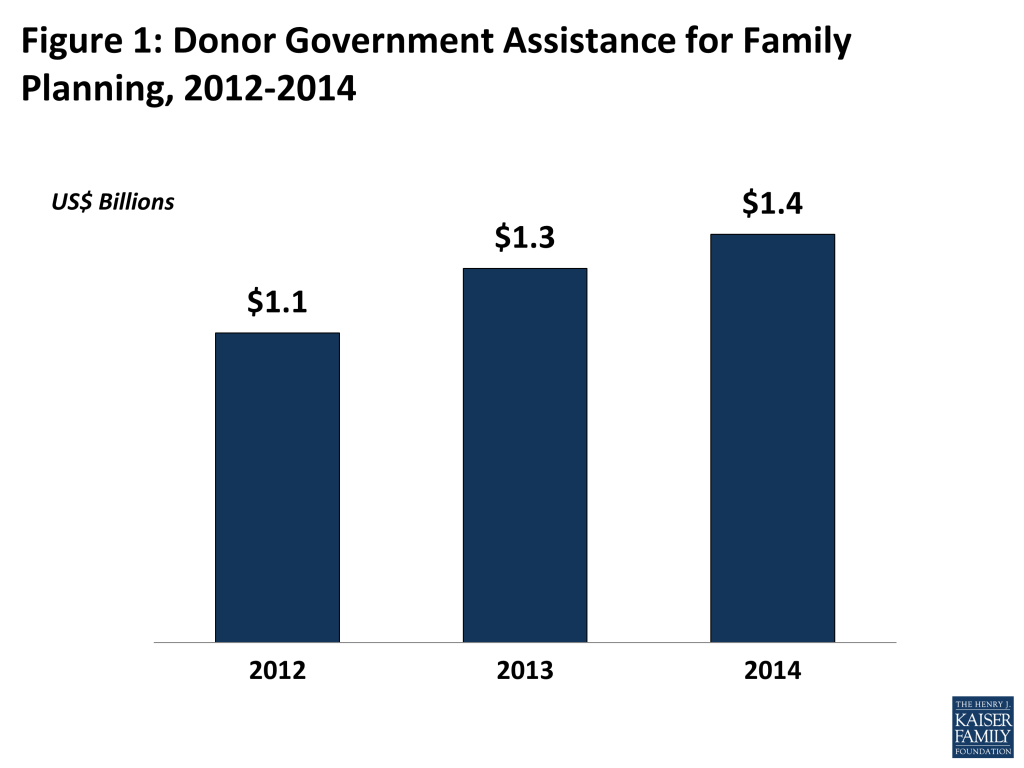
Among the donor governments profiled, seven (Canada, Denmark, France, Netherlands, Sweden, U.S., and U.K.) increased bilateral funding in 2014 (after exchange rate fluctuations are taken into account); two donors (Australia and Norway) remained essentially flat and one donor (Germany) decreased funding for family planning in 2014 (although, Germany increased funding for broader reproductive health activities). Most of the overall increase was due to increases in funding by the U.S., France, the U.K., and Sweden.
The United States (US$636.6 million) was the largest bilateral donor in 2014 accounting for almost half (44%) of total bilateral assistance (see Figure 2). The U.K. (US$327.6 million, 23%) was the second largest bilateral donor, followed by the Netherlands (US$163.6 million, 11%), Sweden (US$70.2 million, 5%), and France (US$69.6 million, 3%).
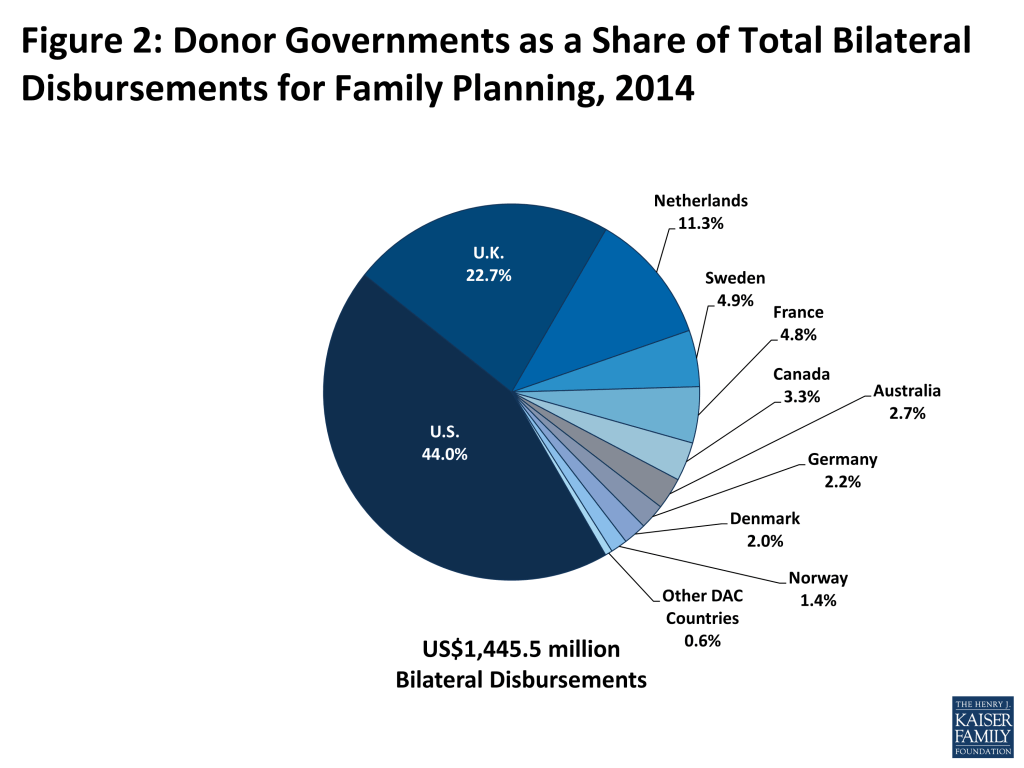
Progress Towards FP2020 Commitments
Eight of the donor governments surveyed directly made multi-year commitments at the FP2020 Summit in 2012: Australia, Denmark, France, Germany, Netherlands, Norway, Sweden, and the U.K. (see Appendix 2). While it is not possible to know what funding amounts would have been provided by donors in the absence of the Summit, data collected for 2012-2014 indicate that funding has increased since the 2012 baseline level and all donors are currently on track to fulfill their stated commitments. While the goals of the FP2020 Summit have a 2020 deadline, commitments from four of the donors profiled (France, Germany, the Netherlands, and Sweden) will conclude in 2015 and one donor (Australia) will conclude in 2016. Future analyses will continue to monitor funding disbursed towards these commitments as well as the trends once commitments have concluded.
Donor Contributions to UNFPA
While the majority of donor government assistance for family planning is provided bilaterally, donors also provide support for family planning activities through contributions to the United Nations Population Fund (UNFPA) (see Box 3). Most of UNFPA’s funding is from donor governments, which provide funding in two ways: 1) donor directed or earmarked contributions for specific activities (e.g. donor contributions to the Global Programme to Enhance Reproductive Health Commodity Security at UNFPA), which are included as part of bilateral funding; and 2) general contributions to “core” activities that are untied and meant to be used for both programmatic activities (family planning, population and development, HIV-AIDS, Gender, and sexual and reproductive health and rights) and operational support as determined by UNFPA.
Box 3: United Nations Population Fund (UNFPA) Mission, Mandate, & London Summit onFamily Planning Commitment
Created in 1969, UNFPA supports sexual and reproductive health activities in many low- and middle-income countries and was a key partner in the London Summit on Family Planning.
UNFPA Mission: Deliver a world where every pregnancy is wanted, every birth is safe, every young person’s potential is fulfilled.
UNFPA Mandate:
- Build the knowledge and the capacity to respond to needs in population and family planning;
- Promote awareness in both developed and developing countries of population problems and possible strategies to deal with these problems;
- Assist their population problems in the forms and means best suited to the individual countries’ needs; and
- Assume a leading role in the United Nations system in promoting population programmes, and to coordinate projects supported by the Fund.
UNFPA London Summit on Family Planning Commitment: “UNFPA will double the proportion of its resources focused on family planning from 25% to 40 % based on current funding levels, bringing new funding of at least US$174 million per year from core and noncore funds. This will include a minimum of US$54 million per year, from 2013-2019, in increased funding for family planning from UNFPA’s core resources.”
In 2014, donor governments provided US$472 million in core contributions to UNFPA, an increase of US$15 million (3%) above 2013 levels (US$457 million) and US$34 million (8%) above 2012 levels (US$438 million). Sweden was the largest donor to UNFPA (US$70.3 million, 15%), followed by Norway (US$69.1 million, 15%), the Netherlands (US$48.4 million, 10%), Denmark (US$41.9 million, 9%), the U.K. (US$33.1 million, 7%), and the U.S. (US$31.1 million, 7%) (see Figure 3).11 Among the ten donors profiled, two provided a larger contribution to UNFPA’s core resources than their total bilateral disbursement for family planning: Denmark and Norway.
| Table 2: Donor Government Contributions to UNFPA (Core Resources), 2012-2014 (US$ millions) | |||||
| Country | 2012 | 2013 | 2014 | Difference* | |
| 2013 – 2014 | 2012 – 2014 | ||||
| Australia | $14.9 | $15.6 | $13.9 | -$1.7 | -$0.9 |
| Canada | $17.4 | $16.0 | $14.0 | -$2.0 | -$3.3 |
| Denmark | $44.0 | $40.8 | $41.9 | $1.1 | -$2.1 |
| France | $0.5 | $0.5 | $0.7 | $0.2 | $0.2 |
| Germany | $20.7 | $24.0 | $24.7 | $0.7 | $3.9 |
| Netherlands | $49.0 | $52.4 | $48.4 | -$3.9 | -$0.6 |
| Norway | $59.4 | $70.6 | $69.1 | -$1.4 | $9.7 |
| Sweden | $66.3 | $65.8 | $70.3 | $4.5 | $4.0 |
| U.K. | $31.8 | $31.5 | $33.1 | $1.5 | $1.3 |
| U.S. | $30.2 | $28.5 | $31.1 | $2.7 | $0.9 |
| Other Donors | $103.3 | $111.4 | $124.6 | $13.2 | $21.4 |
| Total | $437.5 | $457.1 | $471.9 | $14.8(3.2%) | $34.4(7.9%) |
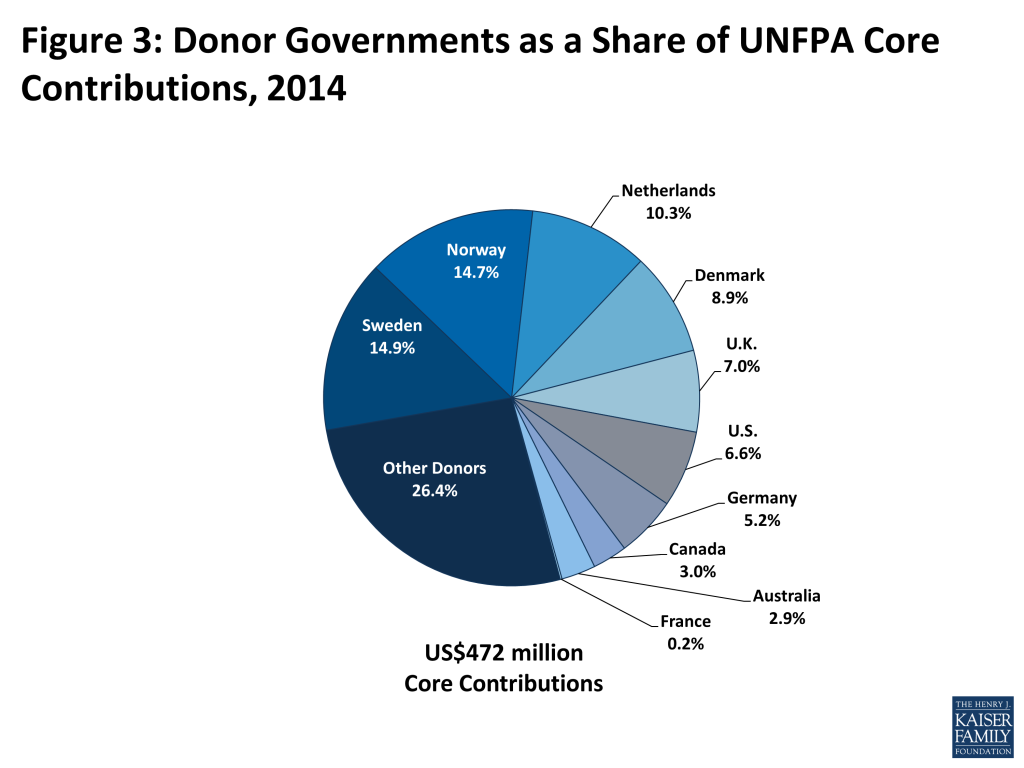
Conclusion
Donor government funding for family planning increased in 2014 marking the second consecutive year of increases since donors made commitments to increase funding at the London Summit on Family Planning in 2012. Additionally, the eight donor governments profiled who made commitments at the London Summit are all on track towards fulfilling them. Looking ahead, however, it is not yet certain if these trends will continue, as several donors are nearing the end of their commitment period and overall bilateral development assistance is projected to be constrained among many of the donor governments.12 It will therefore be important to continue tracking funding for family planning activities to assess progress towards addressing ongoing family planning needs in low- and middle-income countries.
Methodology
Bilateral and multilateral data on donor government assistance for FP in low- and middle-income countries were collected from multiple sources. The research team collected the latest bilateral assistance data directly for ten governments: Australia, Canada, Denmark, Germany, France, the Netherlands, Norway, Sweden, the United Kingdom, and the United States during the first half of 2015. Unless otherwise specified, data represent the fiscal year 2014 period for all governments. Direct data collection from these donors was desirable because they represent the preponderance of donor government assistance for family planning and the latest official statistics – from the Organisation for Economic Co-operation and Development (OECD) Creditor Reporting System (CRS) (see: http://www.oecd.org/dac/stats/data) – are from 2013 and do not include all forms of international assistance (e.g., funding to countries such as Russia and the Baltic States that are no longer included in the CRS database). In addition, the CRS data may not include certain funding streams provided by donors, such as FP components of mixed-purpose grants to non-governmental organizations. Data for all other OECD DAC member governments – Austria, Belgium, the European Commission, Finland, Greece, Ireland, Italy, Japan, Korea, Luxembourg, New Zealand, Portugal, Spain, and Switzerland – who collectively accounted for less than one percent of bilateral family planning disbursements, were obtained from the OECD CRS and are from calendar year 2013.
For purposes of this analysis, funding was counted as family planning if it met the OECD CRS purpose code definition: “Family planning services including counselling; information, education and communication (IEC) activities; delivery of contraceptives; capacity building and training.” Where it was possible to identify funding amounts, family-planning-related activities funded in the context of other official development assistance sectors (e.g. education, civil society) are included in this analysis. Project-level data were reviewed for Canada, Denmark, France, Germany, the Netherlands, Norway, and Sweden to determine whether all or a portion of the funding could be counted as family planning. Family-planning-specific funding totals for the United States were obtained through direct communications with government representatives. Funding attributed to Australia and the United Kingdom is based on a revised Muskoka methodology as agreed upon by donors at the London Summit on Family Planning in 2012. Funding totals presented in this analysis should be considered preliminary estimates based on data provided by representatives of the donor governments who were contacted directly.
It was difficult in some cases to disaggregate bilateral family planning funding from broader reproductive and maternal health totals, as the two are sometimes represented as integrated totals. In addition, family-planning-related activities funded in the context of other official development assistance sectors (e.g. education, civil society) have in the past remained largely unidentified. For purposes of this analysis, we worked closely with the largest donors to family planning to identify such family-planning-specific funding where possible (see Appendix 1 for detailed data table).
Bilateral funding is defined as any earmarked (FP-designated) amount and includes family planning-specific contributions to multilateral organizations (e.g. non-core contributions to the Global Programme to Enhance Reproductive Health Commodity Security at UNFPA). UNFPA contributions from all governments correspond to amounts received during the 2014 calendar year, regardless of which contributor’s fiscal year such disbursements pertain to.
With some exceptions, bilateral assistance data were collected for disbursements. A disbursement is the actual release of funds to, or the purchase of goods or services for, a recipient. Disbursements in any given year may include disbursements of funds committed in prior years, and in some cases, not all funds committed during a government fiscal year are disbursed in that year. In addition, a disbursement by a government does not necessarily mean that the funds were provided to a country or other intended end-user. Enacted amounts represent budgetary decisions that funding will be provided, regardless of the time at which actual outlays, or disbursements, occur. In recent years, most governments have converted to cash accounting frameworks, and present budgets for legislative approval accordingly; in such cases, disbursements were used as a proxy for enacted amounts. In the U.S. case, both enacted and disbursement data were available for analysis.
UNFPA core contributions were obtained from United Nations Executive Board documents. UNFPA estimates of total family planning funding provided from both core and non-core resources were obtained through direct communications with UNFPA representatives. Other than core contributions provided by governments to UNFPA, un-earmarked core contributions to United Nations entities, most of which are membership contributions set by treaty or other formal agreement (e.g., United Nations country membership assessments), are not identified as part of a donor government’s FP assistance even if the multilateral organization in turn directs some of these funds to FP. Rather, these would be considered as FP funding provided by the multilateral organization, and are not considered for purposes of this report.
The fiscal year period varies by country. The U.S. fiscal year runs from October 1-September 30. The Australian fiscal year runs from July 1-June 30. The fiscal years for Canada and the U.K. are April 1-March 31. Denmark, France, Germany, the Netherlands, Norway, and Sweden use the calendar year. The OECD uses the calendar year, so data collected from the CRS for other donor governments reflect January 1-December 31. Most UN agencies use the calendar year and their budgets are biennial.
All data are expressed in US dollars (USD). Where data were provided by governments in their currencies, they were adjusted by average daily exchange rates to obtain a USD equivalent, based on foreign exchange rate historical data available from the U.S. Federal Reserve (see: http://www.federalreserve.gov/) or in some cases from the OECD. Data obtained from UNFPA were already adjusted by UNFPA to represent a USD equivalent based on date of receipts.
Appendices
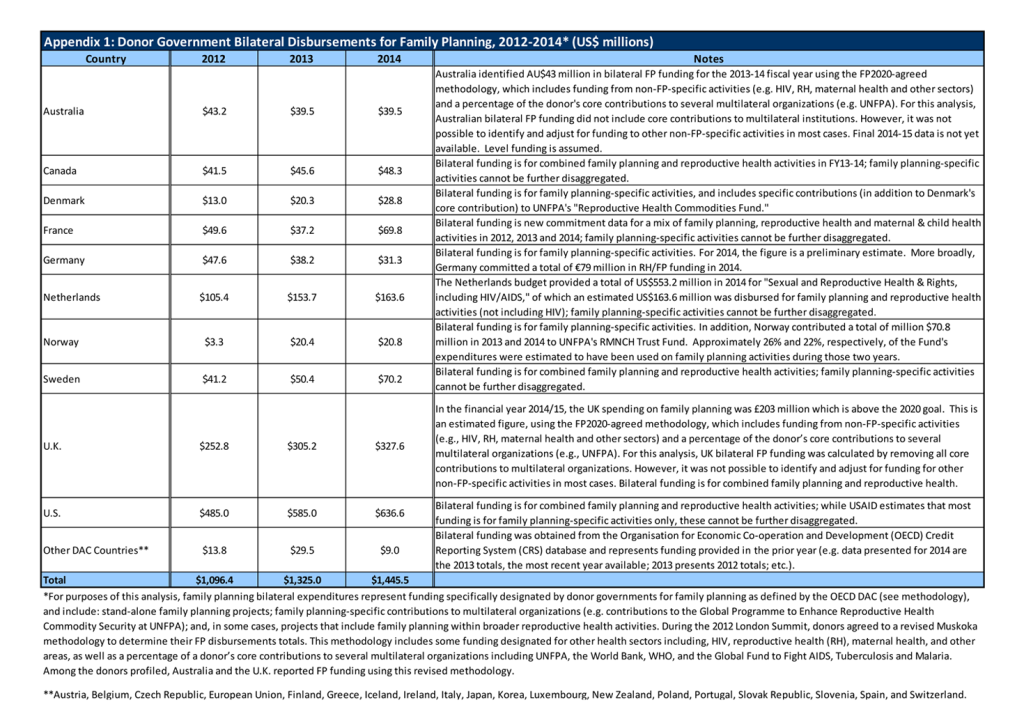
For an enlarged version of the table, access the report PDF.
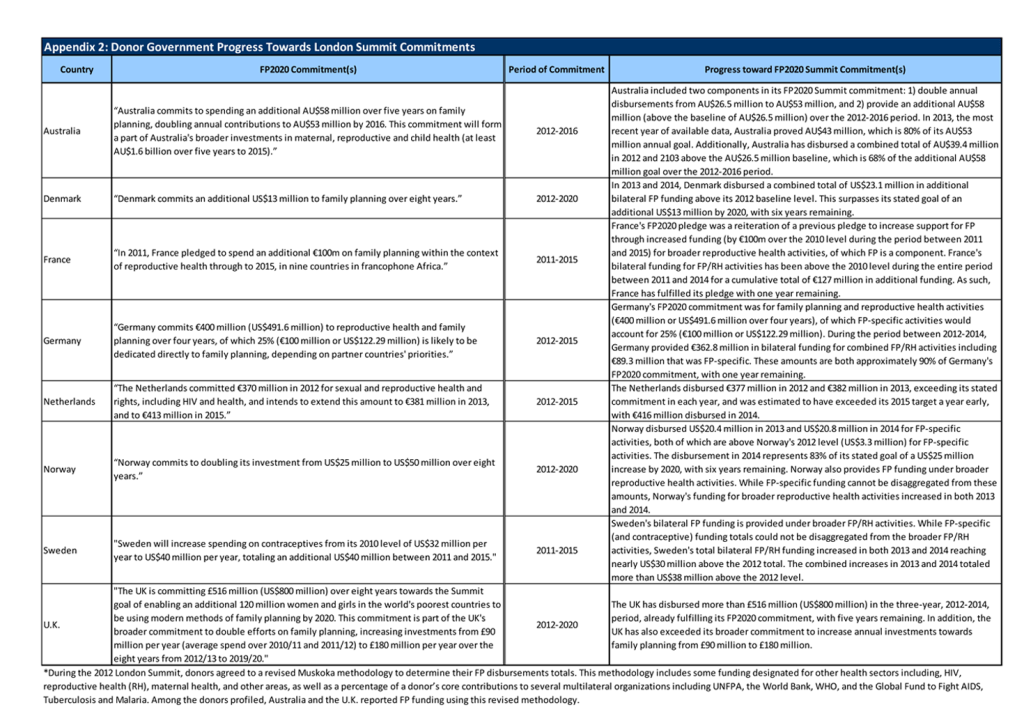
For an enlarged version of the table, access the report PDF.
Endnotes
- Since 2002, the Joint United Nations Programme on HIV/AIDS (UNAIDS) and the Kaiser Family Foundation have been tracking donor government assistance for HIV in low- and middle-income countries by the donor government members of the Organization for Economic Co-operation and Development’s (OECD) Development Assistance Committee (DAC). For the methodological approach used to monitor donor government spending on HIV see: https://modern.kff.org/global-health-policy/report/financing-the-response-to-aids-in-low/. ↩︎
- Includes funding from 28 DAC member countries and the European Commission (EC). ↩︎
- Australia’s FP funding is for the 2013-14 fiscal year. Final 2014-15 data is not yet available. Level funding is assumed. ↩︎
- The European Commission, Japan, and Korea also made commitments during the London Summit. For this analysis, family planning funding from these donor governments is based on family planning funding amounts reported to the OECD DAC and these donors are included as part of “Other DAC Countries”. ↩︎
- In 2014, Finland provided the third largest core contribution ($60.4 million) to UNFPA, followed by the Netherlands. ↩︎
- UNFPA, Financial Resource Flows for Population Activities Report 2011, 2013. ↩︎
- UNFPA, Direct communication, October, 2015. ↩︎
- World Bank, Direct communication, August, 2014. ↩︎
- OECD, The List of CRS Purpose Codes, 2013. ↩︎
- A disbursement is the actual release of funds to, or the purchase of goods or services for, a recipient. An enactment represents a budgetary decision that funding will be provided, regardless of the time at which an actual outlays, or disbursement, occurs. Therefore, disbursements in any given year may include funds committed (enacted) in prior years and in some cases, not all funds committed (enacted) during a government fiscal year are disbursed in that year. While most donor governments examined disburse enacted amounts within the same year, the U.S. government does not and may disburse enactments over multiple years. For instance, in FY 2013, U.S. bilateral enacted funding for family planning activities totaled $615.1 million, while disbursements totaled $585 million. ↩︎
- In 2014, Finland provided the third largest core contribution ($60.4 million) to UNFPA, followed by the Netherlands. ↩︎
- OECD, 2015 Global Outlook on Aid, 2015. ↩︎
